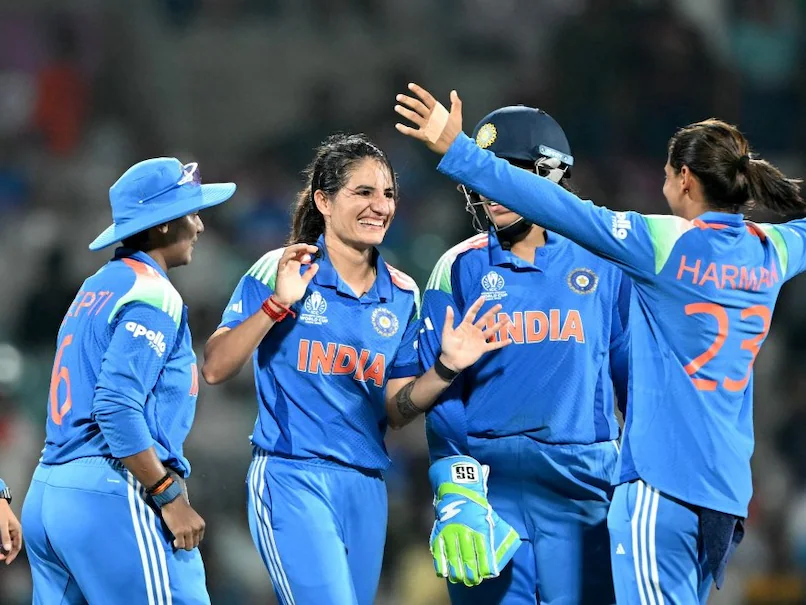Historic Women's World Cup Final: India's Command Against South Africa

Table Of Contents
After a two-hour rain delay that threatened to dampen spirits, South Africa won the toss and elected to field first, hoping to capitalize on favorable bowling conditions. What followed was a masterclass in aggressive batting from the Indian openers, as they laid the foundation for a formidable total.
Shafali Verma and Smriti Mandhana launched a start as ominous as any seen in the tournament, racing to 58 for no loss in eight overs. The Indian pair dismantled the South African bowling attack with clinical precision, establishing a commanding platform that would prove crucial throughout the innings.
Shafali Verma, who had rejoined the squad before the semifinal following Pratika Rawal's injury, announced her return to form in spectacular fashion. Shafali produced a brilliant 87-run knock off 78 balls, studded with seven fours and two sixes, marking her first ODI fifty in over three years. Her aggressive approach, particularly her willingness to step out to the seamers, kept the South African bowlers constantly under pressure.
The Opening Partnership That Electrified Navi Mumbai
The foundation of India's imposing total was built on the century partnership between the openers. Shafali and vice-captain Smriti Mandhana added 104 for the opening wicket at nearly seven runs per over, sending the capacity crowd into raptures and putting South Africa immediately on the back foot.
Mandhana, displaying her trademark elegance, unfurled her two favorite shots, the back-cut and the cover drive, against Khaka in a 14-run sixth over. Though she fell for 45, her contribution in setting the tempo proved invaluable for India's eventual total.
The dismissal of Mandhana came through an attempt to late-cut left-arm spinner Chloe Tryon that ended as an outside edge to the keeper, breaking the partnership that had threatened to take the game completely away from South Africa.
Middle-Order Resilience and South African Fightback
As often happens in high-stakes encounters, the middle overs witnessed a fascinating battle between bat and ball. South Africa pulled things back courtesy of Nadine de Klerk's straighter lines and left-arm spinner Nonkululeko Mlaba's pace variations, with India scoring only 13 runs in the five overs from the ninth to the 13th.
The Proteas found crucial breakthroughs to stem the flow of runs. A tiring, cramping Shafali fell after adding 16 runs to her previous ODI best of 71 not out, holing out while looking to hit straight and big. The loss of the set batter could have derailed India's momentum, but the depth in their batting lineup came to the fore.
Captain Harmanpreet Kaur and Jemimah Rodrigues attempted to rebuild, but South Africa maintained their pressure. Jemimah Rodrigues, who had been in sublime form throughout the tournament, couldn't replicate her semifinal heroics, falling to another precise delivery from the disciplined South African attack.
Deepti Sharma's Anchoring Performance
In conditions where neither batters nor bowlers could completely dominate, Deepti Sharma emerged as the stabilizing force India desperately needed. Deepti had been a busy presence, slog-sweeping with authority when she could and keeping the strike turning over when she couldn't.
Her composed half-century ensured India didn't collapse after losing wickets in clusters. Deepti brought up her 18th women's ODI fifty, her sixth against South Africa and her third at this tournament, showcasing her reliability in pressure situations. Her partnership with Richa Ghosh towards the end added crucial runs that could prove decisive in the final outcome.
The Death Overs Drama
As the innings approached its conclusion, India aimed to accelerate towards an imposing 320-plus total. However, South Africa made their comeback through Ayabonga Khaka who finished with figures of 3/58 from nine overs, and Nonkululeko Mlaba with 1/47, triggering a middle-overs slide to deny the hosts the 300-mark.
Richa Ghosh provided late impetus with a breezy cameo, finding boundaries and lifting the scoring rate when it mattered most. The final few overs witnessed high drama, with India pushing for every possible run while South Africa desperately tried to restrict them under 300.
India finished with 298/7, posting the second-highest score in a Women's ODI World Cup final. While the hosts would have ideally wanted to breach the 300-mark, the total remained formidable, especially considering the pitch conditions that suggested the ball was gripping and stopping periodically.
Early South African Response
Chasing 299 under the lights of Navi Mumbai, South Africa needed their experienced openers to provide a solid platform. However, India struck early to peg back the Proteas. Following a run-out, Sree Charani got Anneke Bosch on her pads and the umpire raised the finger without any hesitations, leaving South Africa reeling and facing an uphill battle.
The early wickets put immense pressure on the South African middle order, who now needed to rebuild while maintaining the required run rate. With the experienced Laura Wolvaardt at the crease, the Proteas still harbored hopes of mounting a successful chase, but India's bowlers, backed by vociferous home support, had their tails up.
Historical Context and Tournament Significance
This final carried immense historical weight for both nations. For India, it represented their third appearance in a Women's World Cup final, having previously fallen short in 2005 against Australia and in 2017 against England. The wounds from those near-misses, particularly the 2017 final at Lord's where India collapsed from a winning position, remained fresh in memory.
South Africa, making their maiden final appearance, had defied expectations throughout the tournament. Their emphatic semifinal victory over England demonstrated their credentials as genuine contenders. The Proteas' journey to the final represented a breakthrough moment for South African women's cricket, regardless of the final outcome.
The match also held special significance as it featured two teams hungry for their first ICC World Cup title in either the 50-over or T20 format. The absence of traditional powerhouses Australia and England made this final a watershed moment for women's cricket, proving the sport's growing depth and competitiveness.
Tactical Battles and Key Matchups
The final showcased several intriguing individual battles. Marizanne Kapp, the most prolific wicket-taker in Women's ODI World Cup history, had the responsibility of unsettling the dangerous Smriti Mandhana with the new ball. The pitch at DY Patil, known for high scores but showing signs of grip and variable bounce, added another dimension to the tactical battle.
India's six-bowler strategy gave them flexibility and depth, while South Africa's decision to maintain their winning combination showed confidence in their established unit. The pitch conditions, which prevented either side from completely dominating, created a compelling contest that ebbed and flowed throughout both innings.
The Road to the Final
India's journey to the final had been nothing short of spectacular. Their semifinal victory over defending champions Australia, achieved through one of the greatest ODI chases in recent memory, had set the tone for their title aspirations. Jemimah Rodrigues' unbeaten 127 and Harmanpreet Kaur's composed 89 in that match had showcased India's depth and ability to handle pressure.
South Africa's path had been equally impressive, marked by their clinical 125-run victory over England in the semifinals. Laura Wolvaardt's consistent run-scoring, complemented by the all-round brilliance of Marizanne Kapp and the crafty left-arm spin of Nonkululeko Mlaba, had given them the balance and belief to compete at the highest level.
Conclusion
As the match progressed under the Navi Mumbai lights, one team stood on the cusp of cricketing immortality. India's commanding total of 298/7, built on Shafali Verma's explosive 87 and Deepti Sharma's composed fifty, had set up a thrilling chase. South Africa's early setbacks made their task mountainous, but in a World Cup final, anything remained possible until the last ball was bowled.
This historic encounter represented more than just a cricket match—it symbolized the evolution and growth of women's cricket globally. Regardless of the final result, both teams had already secured their place in the annals of the sport's history by reaching this landmark final and showcasing the talent, determination, and passion that define modern women's cricket.




FAQS
Top Teams
- India
- New Zealand
- Australia
- England
- South Africa
- Bangladesh
- Pakistan
Top Leagues
- Indian Premier League
- Women's Premier League
- Big Bash League
- T20 Mumbai Premier League
- The Hundred
- Caribbean Premier League
- Lanka Premier League
- Maharashtra Premier League
- Tamil Nadu Premier League
More Links
- Twitter trendings
- Off Field Talks
- Pitch Analysis
- Team Analysis
- Player Analysis
- Match Prediction
- Toss Prediction










